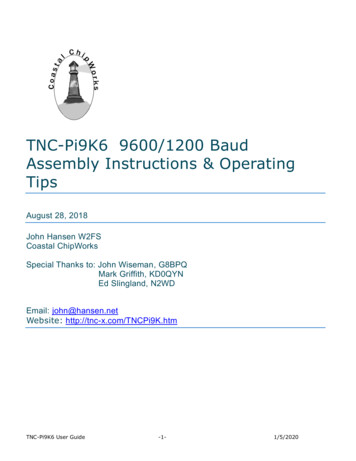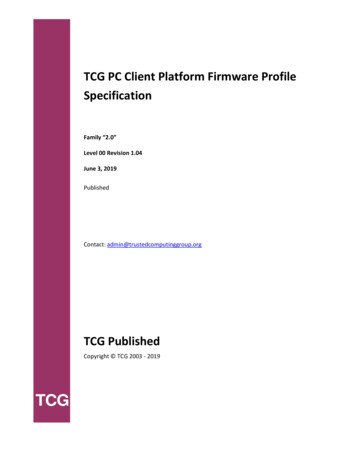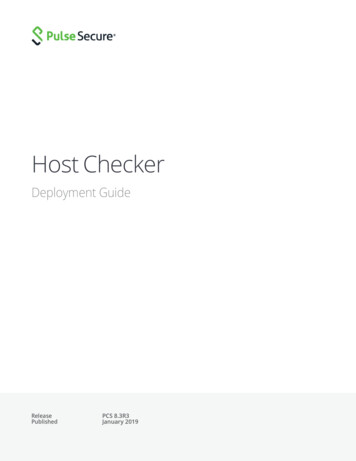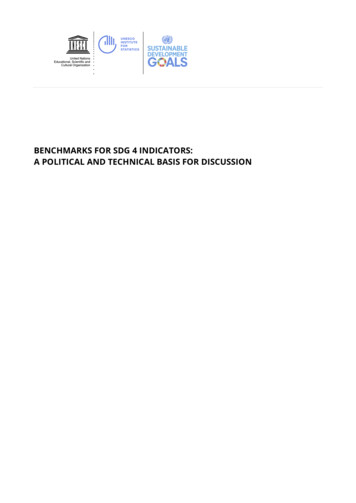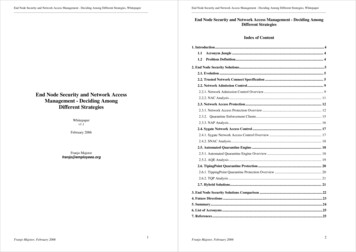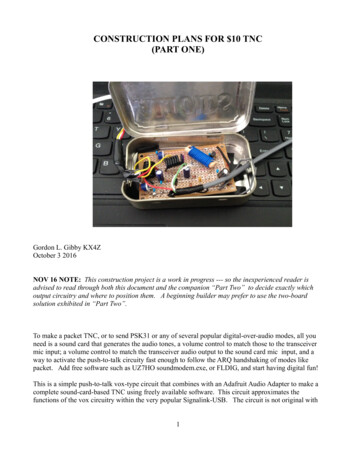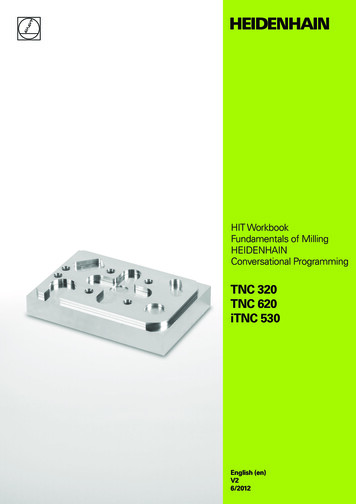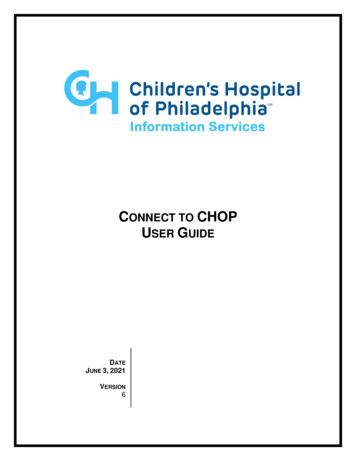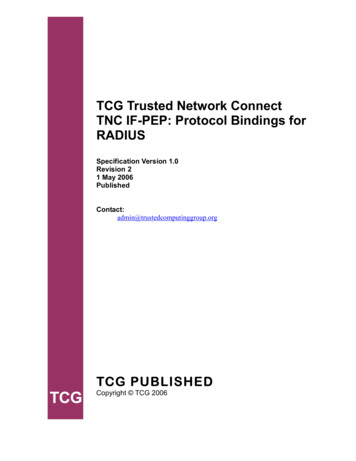
Transcription
TCG Trusted Network ConnectTNC IF-PEP: Protocol Bindings forRADIUSSpecification Version 1.0Revision 21 May rgTCG PUBLISHEDTCGCopyright TCG 2006
TCG CopyrightSpecification Version 1.0Copyright 2006 Trusted Computing Group, Incorporated.DisclaimerTHIS SPECIFICATION IS PROVIDED "AS IS" WITH NO WARRANTIES WHATSOEVER, INCLUDINGANY WARRANTY OF MERCHANTABILITY, NONINFRINGEMENT, FITNESS FOR ANY PARTICULARPURPOSE, OR ANY WARRANTY OTHERWISE ARISING OUT OF ANY PROPOSAL, SPECIFICATIONOR SAMPLE. Without limitation, TCG disclaims all liability, including liability for infringement of anyproprietary rights, relating to use of information in this specification and to the implementation of thisspecification, and TCG disclaims all liability for cost of procurement of substitute goods or services, lostprofits, loss of use, loss of data or any incidental, consequential, direct, indirect, or special damages,whether under contract, tort, warranty or otherwise, arising in any way out of use or reliance upon thisspecification or any information herein.No license, express or implied, by estoppel or otherwise, to any TCG or TCG member intellectualproperty rights is granted herein.Except that a license is hereby granted by TCG to copy and reproduce this specification forinternal use only.Contact the Trusted Computing Group at www.trustedcomputinggroup.org for information on specificationlicensing through membership agreements.Any marks and brands contained herein are the property of their respective owners.Revision 2PublishedTCG PUBLISHEDPage ii of 25
TCG CopyrightSpecification Version 1.0IWG TNC Document RoadmapRevision 2PublishedTCG PUBLISHEDPage iii of 25
TCG CopyrightSpecification Version 1.0Table of ContentsAcknowledgements . v1 Introduction . 61.11.22Scope and Audience . 6Keywords . 6Background . 72.1 Purpose of IF-PEP . 72.1.1Supported Use Cases . 72.1.2Non-supported Use Cases . 82.2 Requirements. 82.3 Assumptions. 92.4 Out of Scope . 92.5 Features Provided by IF-PEP . 102.5.1Endpoint Isolation. 102.5.2Network Access Decision Transport . 102.5.3Support of Remediation and Handshake Retry. 103Isolation Techniques and Use Cases . 113.13.23.34Binary-based Isolation. 11VLAN-based Isolation . 11Filter-Based Isolation . 11IF-PEP for Network-Based PEPs . 134.14.25Model. 13NAA and PEP Requirements related to TNC . 14RADIUS as IF-PEP Transport Protocol. 155.1 Why RADIUS? . 155.2 Relevant RFCs. 155.3 Isolation Techniques Mapped to RADIUS Attributes . 155.3.1Binary Isolation . 155.3.2VLAN-based Isolation. 165.3.3Filter-based Isolation . 165.4 Remediation and Handshake Retry Mapped to RADIUS . 165.5 NAA and PEP Requirements related to RADIUS . 176Security Considerations. 186.1 Threat Analysis . 186.1.1Rogue NAA. 186.1.2Threats beyond IF-PEP. 186.2 Suggested Remedies. 187Use Case Walkthrough . 197.17.27.37.47.589Configuration. 19Network Connect. 19Handshake Retry . 19Sequence Diagram for Network Connect . 20Sequence Diagram for Handshake Retry . 20References. 21Annex A: PEP Embodiment Spectrum . 229.1 PEP Types . 229.1.1Network-based PEP . 229.1.2Endpoint-based PEP .239.1.3Server-based PEP. 249.1.4Fully Integrated Endpoint . 24Revision 2PublishedTCG PUBLISHEDPage iv of 25
TCG CopyrightSpecification Version 1.0AcknowledgementsThe TCG wishes to thank all those who contributed to this specification. This document builds onnumerous works done in the various working groups in the TCG.Special thanks to the members of the TNC contributing to this document:Mahalingam ManiAvayaKazuaki NimuraFujitsu LimitedBoris BalacheffHewlett-PackardMauricio Sanchez (Editor)Hewlett-PackardDianna ArroyoIBMLee TerrellIBMRavi SahitaIntelNed SmithIntelBarbara NelsoniPassSteve Hanna (TNC co-chair)Juniper NetworksGene ChangMeetinghouse Data CommunicationsJohn VollbrechtMeetinghouse Data CommunicationsSandilya GarimellaMotorolaJoseph TardoNevis NetworksThomas HardjonoSignaCert, Inc.Bryan KingsfordSymantecRich LangstonSymantecBabak SalimiSymantecPaul Sangster (TNC co-chair)SymantecScott CochraneWave SystemsGreg KazimierczakWave SystemsDoug KleinVernier NetworksRevision 2PublishedTCG PUBLISHEDPage v of 25
TCG CopyrightSpecification Version 1.01 Introduction1.1 Scope and AudienceThe Trusted Network Connect Sub Group (TNC-SG) is defining an open solution architecture thatenables network operators to enforce policies regarding endpoint integrity when granting accessto a network infrastructure. Part of the TNC architecture is IF-PEP, a standard interface betweenthe Policy Decision Point (PDP) and the Policy Enforcement Point (PEP). This document definesand specifies IF-PEP using RADIUS (Remote Authentication Dial In User Service) [7].Architects, designers, developers and technologists who wish to implement, use, or understandIF-PEP should read this document carefully. Before reading this document any further, the readershould review and understand the TNC architecture as described in [8].1.2 KeywordsThe key words “MUST”, “MUST NOT”, “REQUIRED”, “SHALL”, “SHALL NOT”, “SHOULD”,“SHOULD NOT”, “RECOMMENDED”, “MAY”, and “OPTIONAL” in this document are to beinterpreted as described in RFC 2119 [4].This specification does not distinguish blocks of informative comments and normativerequirements. Therefore, for the sake of clarity, note that lower case instances of must, should,etc. do not indicate normative requirements.Revision 2PublishedTCG PUBLISHEDPage 6 of 25
TCG CopyrightSpecification Version 1.02 Background2.1 Purpose of IF-PEPThis document describes and specifies IF-PEP protocol bindings for RADIUS. For the purposesof this document, this document will refer to IF-PEP for RADIUS as just IF-PEP. Future versionsof this specification may describe additional protocol bindings with other protocols, such asDiameter [15] or SNMP [16]. IF-PEP allows communication between the PDP’s Network AccessAuthority (NAA) and the Policy Enforcement Point (PEP).IF-PEP is used to send network access decisions from the NAA to the PEP so the PEP canenforce those decisions on an endpoint’s network traffic. By the time IF-PEP is used, the integritystate of the endpoint has already been established, the NAA has made a network accessdecision, and the PEP is ready to enforce the decision under direction of the NAA.The network access decision should be considered an event that necessitates some action by thePEP, whether to allow unimpeded access (e.g. for an endpoint that complies with policy) orisolation (e.g. for an endpoint that does not comply with policy). Isolation in TNC may consist ofno access or limited access. In particular for non-compliant endpoints, there is a clear need todescribe the steps and interaction involving the AR, PEP, and PDP that must be undertaken todynamically alter the PEP’s enforcement: first, enforcing isolation while the endpoint performsremediation, and later removing isolation.This document describes a standard set of isolation techniques available for performing endpointisolation and specifies the RADIUS protocol bindings and requirements for both an NAA and PEPrelating to each isolation technique. Isolation techniques are presented by their relevant networklayer and a use case for each is described. For each isolation technique, a mapping to RADIUSis specified by describing the RADIUS messages or attributes that are to be utilized. Otherdocuments may later be written to describe how other isolation techniques may be implemented.Architects, designers, developers and technologists who wish to implement and use IF-PEPMUST abide to this document.2.1.1 Supported Use CasesUse cases that this version of IF-PEP supports are as follows: An access requestor (AR) is attempting network access through an 802.1X-enabledwired Ethernet (IEEE802.3) switch policy enforcement point (PEP) that is controlled bya RADIUS-based policy decision point (PDP). An access requestor (AR) is attempting network access through an 802.1X-enabledwireless (IEEE802.11) access point based policy enforcement point (PEP) that iscontrolled by a RADIUS-based policy decision point (PDP). An access requestor (AR) is attempting network access through an IPsec VPN serverpolicy enforcement point (PEP) that is controlled by a RADIUS-based policy decisionpoint (PDP). A policy decision point (PDP) may need to update the access policy enforced by thepolicy enforcement point (PEP) without having the access requestor (AR) losenetwork connectivity. A policy decision point (PDP) may at different times enforce different integritycompliance requirements on an access requester (AR) that require changes to theaccess policy enforced by the policy enforcement point (PEP).Revision 2PublishedTCG PUBLISHEDPage 7 of 25
TCG CopyrightSpecification Version 1.0 An access requestor (AR) is attempting network access through a non-802.1X or nonIPsec policy enforcement point (PEP) that is controlled by a RADIUS-based policydecision point (PDP).2.1.2 Non-supported Use CasesSeveral use cases, but not limited to these, not covered is this version of IF-PEP are as follows: An access requestor (AR) is attempting network access through a non-network basedpolicy enforcement point (PEP) that is controlled by a non-RADIUS based policydecision point (PDP). Descriptions for the various forms of PEP embodiments can befound in Annex A.oA non-network based PEP consists of an enforcement entity that is a physicaland/or logical component of either the AR or the PDP. Additional discussionabout the various embodiments for TNC policy enforcement points can be foundin Annex A.oFurthermore, this use case means that only RADIUS is supported. Otherprotocols, such as SNMP, or not supported. An access requester may connect one network with a protected network (e.g., site tosite VPN). An access requester (AR) is granted access to a single device based on compliance.oIn this use case, the single device the AR is accessing implements both PEP andPDP functionality in addition to its nominal endpoint role (e.g. network attachedprinter, file server, etc.).2.2 RequirementsThe following are the requirements which IF-PEP must meet in order to successfully play its rolein the TNC architecture. These are stated as general requirements, with specific requirementscalled out as appropriate.a. Meets the needs of the TNC architectureIF-PEP must support all the functions and use cases described in the TNC architectureas they apply to the relationship between the NAA and the PEP.Specific requirements include:ooooIF-PEP should support various methods of isolation for endpoints that failintegrity verification.IF-PEP must be compatible and usable with network access technologiessupporting the TNC architecture, especially 802.1X networks and IPsec VPNs.IF-PEP must be compatible and usable with message transport technologiessupporting the TNC architecture, such as tunnel EAP methods.IF-PEP must be compatible and usable with authentication server technologiessupporting the TNC architecture, namely RADIUS.b. SecureThe communications between a PEP and NAA must be protected. A PEP and NAA mustprovide its own security mechanisms as suggested in the Security Considerationssection.Specific requirements include:Revision 2PublishedTCG PUBLISHEDPage 8 of 25
TCG CopyrightSpecification Version 1.0ooCommunication between a PEP and NAA server must be authenticated and itsintegrity maintained.Communication between a PEP and NAA server should be confidential.c. ExtensibleIF-PEP will need to expand over time as new features and supported network, message,and authentication technologies are added to the TNC architecture. IF-PEP must allownew features to be added easily, providing for a smooth transition and allowing newerand older architectural components to work together.d. Easy to use and implementIF-PEP should be easy for PEP and NAA vendors to use and implement. It should allowthem to enhance existing products to support the TNC architecture and integrate legacycode without requiring substantial changes. IF-PEP should also make things easy forsystem administrators and end-users. Components of the TNC architecture should plugtogether automatically without requiring extensive manual configuration.e. Substantially network media independentIF-PEP must not be solely limited to supporting just Ethernet networks. It must beapplicable for other network types.2.3 AssumptionsHere are the assumptions that this document makes about components in the TNC architecture. Network access decisionThe network access decision is about limiting network access in some way. The networkdecision is derived from the TNCS’ recommendation – allow, deny, or isolate. NAA and RADIUSThe NAA of a TNC PDP is a RADIUS server. Control of PEPThe PEP is under the control of the NAA. A PEP cannot change an NAA deny network decision to either allow, or isolate.A PEP can reject an NAA’s allow or isolate network decision, if it is incapable of fullyenforcing the decision because, but not limited to, mis-configuration, PEP resourcedepletion, or violation of local PEP security policy.2.4 Out of ScopeWhile IF-PEP does allow passage of network access policy between the NAA and the PEP, itdoes not facilitate all configuration or management tasks/processes between both. Severalnoteworthy items that have been identified as out of scope for this version of IF-PEP include: The NAA and PEP are each in different administrative domainsDiscussion on how to handle an NAA and PEP that are each under the control of adifferent administrative entity is out of scope. Control of multiple PEPs concurrentlyRevision 2PublishedTCG PUBLISHEDPage 9 of 25
TCG CopyrightSpecification Version 1.0Discussion on how an NAA can control multiple PEPs concurrently for a given AR accessrequest is out of scope. If multiple PEPs exist in an environment, the network decision isnot communicated to them until the AR attempt to gain access through one of thosePEPs. Reconciliation of PEP and NAA capabilitiesDiscussion on how to reconcile enforcement capabilities or perform capability discoveryis out of scope. The administrator is responsible for reconciling capability differencesbetween the NAA and PEP during solution deployment. That is, he or she is responsiblefor establishing that an NAA can/will instruct the PEP to perform some type of isolation ina meaningful manner.2.5 Features Provided by IF-PEPThis section documents the features provided by IF-PEP.2.5.1 Endpoint IsolationWithin the TNC architecture, a PEP serves the vital role of enforcing network access decisionsand in particular for non-compliant endpoints, it serves to isolate an endpoint’s access to justthose network resources necessary for remediation or basic network access. IF-PEP describesvarious isolation techniques that differ in the network layer (L2, L3, etc.) they affect.2.5.2 Network Access Decision TransportThe NAA needs to communicate to the PEP the network access decision to be enforced for aparticular endpoint. IF-PEP describes the usage of RADIUS messages and Attribute Value Pairs(AVPs) as a means for sending the network access decision from the NAA to the PEP.2.5.3 Support of Remediation and Handshake RetryThe initial network access decision may later be modified. For example, endpoints that are foundto be in non-compliancy may return into compliancy, thereby requiring a PEP to no longer enforcean isolation policy. For such cases, the TNC architecture describes the need for handshakeretries to establish a new integrity decision. IF-IMV [10] and IF-IMC [9] describe the process ofintegrity revalidation. IF-PEP describes the role of the PEP as part of the handshake retry.Revision 2PublishedTCG PUBLISHEDPage 10 of 25
TCG CopyrightSpecification Version 1.03 Isolation Techniques and Use CasesThis section describes the TNC standard set of isolation techniques available for performingendpoint isolation. For each isolation technique, a use case is presented that describes anominal use in a TNC solution.It should be noted that an implementer is free to conceive and deploy additional isolationtechniques (i.e. vendor specific), but MUST support at least one of the three isolation techniquesdescribed herein to be considered TNC compliant.3.1 Binary-based IsolationBinary-based isolation provides an all or none network access proposition. In terms endpointisolation, binary access is the simplest technique. Either the endpoint is allowed onto the networkor it is completely blocked from the network.The use case for binary isolation is to grant network access to compliant endpoints while blockingnetwork access to non-compliant endpoints. While binary isolation is the most straightforwardisolation technique, it does not allow network based remediation; it can prohibit access to thosewith invalid setups, but does not help the network operator provide remediation.3.2 VLAN-based IsolationIn Ethernet environments, virtual LANs (VLANs) allow administrators to logicallycompartmentalize their networks into distinct logical networks while still maintaining the samephysical connection topology. Originally VLANs were positioned as a design tool to improvenetwork performance and scalability by facilitating the creation of multiple layer-2 broadcastdomains. However, the benefits of VLANs have been extended into the network access domainby enabling segregation of network traffic based on security requirements and data sensitivity.The use case for data link layer isolation via VLANs is to compartmentalize endpoints based ontheir endpoint integrity state. It is expected that there may be different levels of restricted access,and therefore different VLAN policies could be used. For example, VLANs can be used forcontainment of non-compliant endpoints in an administrator-defined “Fix-Up” VLAN. Usually thisVLAN has limited connectivity to just those network resources fundamental to the remediationprocess. This could mean only a DHCP, DNS and remediation server would be present on theVLAN. Meanwhile, endpoints that are integrity compliant could be assigned “full-access” VLANaccess.3.3 Filter-Based IsolationFilter-based enforcement refers to setting up filter rules (e.g. ACLs - Access Control Lists) in thePEP such that when a user initiates traffic, the PEP examines the set of rules associated with theservice granted to the user. These rules determine what traffic is allowed to proceed through thePEP and what traffic will be filtered (i.e. blocked).The filtering action usually either permits or denies traffic from traversing a PEP. The PEP willmatch an incoming packet’s network header portions to its permit or deny rule list and determinewhether to allow the packet to continue or be blocked. Packets that are allowed to continue areusually unaltered.The use case for filter-based isolation is to filter traffic based on their endpoint integrity state.Filter-based isolation provides a more granular method for controlling endpoint network accessthan the data link layer isolation method. For example, non-compliant endpoints can be isolatedfrom one another when they reside on the same IP subnet by allowing them to only communicatewith remediation servers, but not amongst themselves. The endpoints are constrained tocommunicating to those just those IP addresses and TCP ports needed for remediation.Revision 2PublishedTCG PUBLISHEDPage 11 of 25
TCG CopyrightSpecification Version 1.0It is expected that there may be different levels of restricted access, and therefore different filterscan be used. As an example, endpoints that are non-compliant might be assigned the “Fix-Up”filter, which could limit access to the IP addresses and TCP ports of just the DNS and remediationserver(s). Meanwhile, endpoints that are integrity compliant could be assigned the “Full-Access”filter, which would impose no IP address or TCP port access restrictions on the endpoint.Revision 2PublishedTCG PUBLISHEDPage 12 of 25
TCG CopyrightSpecification Version 1.04 IF-PEP for Network-Based PEPsThe TNC architecture describes the role of the PEP as the entity that enforces the decisions ofthe NAA regarding network access. In many instances, TNC documentation uses networkdevices (e.g. VPN, 802.1X) as typical embodiments of PEPs. However, the TNC architecturedoes not limit PEPs to just network devices, but rather considers PEPs as logical entities that cantake on a number of different embodiments, as described in Annex A. This version of IF-PEP,however, is limited in scope to treatment of just network-based PEPs.4.1 ModelThe diagram below shows, in the upper-half, the TNC architecture and, in the lower-half, asample representation and relationship between physical entities.IntegrityCollectionLayerARPEPIntegrity MeasurementIntegrity CollectorMeasurementIntegrity -IMCIF-IMVTNCClientIF-TNCCSNetwork AccessRequestorPolicy EnforcementPointSupplicant /VPN Client, etc.Switch/Firewall/VPN k AccessAuthorityAAA ServerIF-PEP(RADIUS)EAPoLRADIUS/EAPLAN SwitchIF-PEP(RADIUS) RADIUS/EAPEAPoLWireless APIF-PEP(RADIUS)PC (Endpoint)IKEv2/EAPServer (PDP)RADIUS/EAPIPSEC-VPN ServerUnprotectedNetworkProtectedNetworkFigure 1 - Network-Based PEP in TNC ArchitectureRevision 2PublishedTCG PUBLISHEDPage 13 of 25
TCG CopyrightSpecification Version 1.0In the diagram, the PC endpoint is trying to acquire network access either over a LAN switch,wireless access point, or IPsec VPN server. The LAN switch, wireless access point, and IPsecVPN server are all examples of network-based PEPs who are under the control by the NAA in thePDP via IF-PEP. In all instances IF-PEP uses RADIUS as a transport protocol foundation.4.2 NAA and PEP Requirements related to TNCThe following are the requirements which an NAA and network-based PEP must meet to functionin the TNC architecture. Both an NAA and PEP MUST implement at least one of the isolation techniquesdescribed in section 3 and SHOULD implement two or more for greater deploymentflexibility. A list of the isolation techniques follows: oBinary- basedoVLAN-basedoFilter-basedBoth an NAA and PEP SHOULD allow one or more isolation techniques to beconcurrently active.For example, VLAN-based isolation coupled with filter-based isolation allows fordeployment scenario whereby multiple endpoints on the same isolation VLAN cannotcommunicate with each other directly. Direct communication between endpoints isprohibited by the traffic filter. An NAA and PEP MAY implement additional vendor-specific isolation techniques thatboth the NAA and PEP have agreed upon. However, the requirement that both the NAAand PEP MUST implement at least one of the three isolation techniques described insection 3 remains. Both an NAA and PEP MUST allow dynamic access policy update. This updateSHOULD be performed without affecting existing network connectivity for the endpoint.The TNC architecture describes the use case for integrity revalidation. Depending on thecapabilities and limitations of various TNC components, it is desirable to performrevalidation without interrupting network connectivity.Revision 2PublishedTCG PUBLISHEDPage 14 of 25
TCG CopyrightSpecification Version 1.05 RADIUS as IF-PEP Transport ProtocolThis section specifies how RADIUS is used as a network access decision transport protocolbetween a TNC PEP and NAA. This section elaborates on: How RADIUS is to be used to meet TNC PEP requirements. RADIUS-specific requirements imposed on the NAA and PEP.5.1 Why RADIUS?Since the TNC architecture is part of the authentication, authorization, and accounting (AAA)architecture, it is only natural that some of the same protocols from contemporary AAAimplementations be pressed into service within the TNC framework. A key AAA protocol isRADIUS.RADIUS is already the popular protocol for providing authentication, authorization, andaccounting (AAA) services in many varied environments, ranging from enterprise to ISP operatorenvironments, and many diverse deployments, spanning from 802.1X, IPsec-VPN, to SSL-VPN.This document described how IF-PEP can be implemented using RADIUS. This allowscompatibility with the huge installed base of network devices that already support RADIUS,easing the deployment of TNC-based solutions.5.2 Relevant RFCsRADIUS is defined by a body of IETF RFC (Request For Comment) documents, not all of whichare relevant for IF-PEP. The table below enumerates the primary RFCs relevant to IF-PEP.RFC NumberTitleRFC2865Remote Authentication Dial In User ServiceRFC2868RADIUS Attributes for Tunnel Protocol SupportRFC3576Dynamic Authorization for RADIUSRFC3579RADIUS support for Extensible Authentication Protocol (EAP)RFC3580IEEE802.1X RADIUS Usage Guidelines5.3 Isolation Techniques
policy enforcement point (PEP) without having the access requestor (AR) lose network connectivity. A policy decision point (PDP) may at different times enforce different integrity compliance requirements on an access requester (AR) that require changes to the access policy enforced by the policy enforcement point (PEP).
